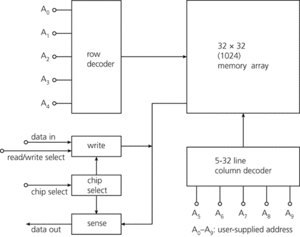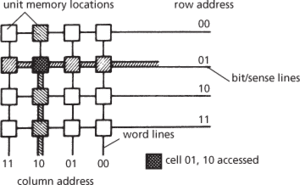1. The main memory of a computer. It is fabricated using semiconductor technology and allows the computer user to access (read from) or alter (write to) individual storage locations within the device (see def. 2).
2. A semiconductor memory device in which the basic element consists of a single cell that is capable of storing one bit of information. Large-capacity memories are formed as two-dimensional arrays of these cells. An individual cell is identified uniquely by row and column addresses, which are derived by decoding a user-supplied address word. A typical organization is shown in the diagram. Each cell in a RAM is thus independent of all other cells in the array and can be accessed in any order and in the same amount of time, hence the term random access; data can be both read from and written to the cells in the array. RAM is usually volatile memory and is used for temporary storage of data or programs.

RAM. Typical organization of a RAM
RAM devices can be classified as static or dynamic. Static RAM (SRAM) is fabricated from either bipolar or MOS components (see bipolar transistor, MOSFET); each cell is formed by an electronic latch whose contents remain fixed until written to or until the power is removed. Dynamic RAM (DRAM) cells, which comprise MOS devices, utilize the charge stored on a capacitance as a temporary store (see bucket); because of leakage currents, the cell contents must be refreshed at regular intervals. The design of RAM chips is evolving and new standards arise frequently. The trend is for RAM to be sold in modules rather than individual chips. See DIMM.
A solid-state memory device which allows reading and writing of data and to which there is random access to the individual memory locations. The memory is arranged as a rectangular array of memory cells forming rows and columns. Each memory cell in the array forms an intersection between the rows and columns. A simple array of 16 storage cells arranged as a 4 × 4 matrix is shown in the diagram. Any individual cell in the array, such as the cell indicated, is defined by the address of one row and one column, as shown, since each row and column intersect once only. Each cell can store one bit of information.
In order to retrieve information from a particular location, the address codes of the row and column are specified. The output is sampled by suitable sensing devices that are attached to each row and the rows are therefore termed bit lines. The columns are known as word lines.

RAM: array of 4 × 4 storage cells
- pleochroism
- pleonaste
- pleonotetic logic
- plerion
- Plesetsk Cosmodrome
- plesiochronous digital hierarchy
- plesiomorph
- plesiomorphic
- plesiomorphy
- plesion
- Plesiorycteropus
- Plesiosauroidea
- plesiosaurs
- pleura
- pleural
- pleuron
- plex
- Plexiglas display screen
- plexus
- PL/I
- plicate
- Pliensbachian
- Plinian eruption
- plinian eruption
- plinthic horizon